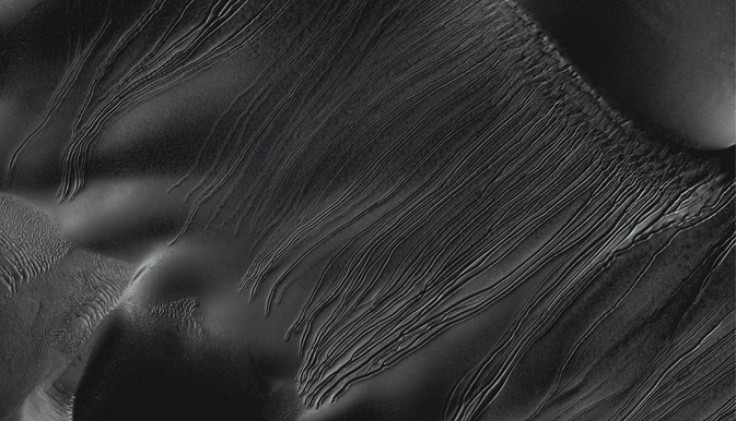Mars Sand Dune Grooves Explained: NASA Spots Tracks Likely Formed By Dry Ice Sliding

When you plan for your Martian summer vacation in a century or so, you may want to pack a snowboard made of frozen carbon dioxide. New research from NASA suggests that certain geological features on Mars were formed by blocks of dry ice sliding down the sides of sand dunes.
"Now I dream of snowboarding down a Martian sand dune on a block of dry ice,” NASA planetary scientist Serina Diniega said in a statement.
The find stemmed from photos snapped by the Mars Reconnaissance Orbiter that show long grooves on Martian dunes, called linear gullies. The gullies have a fairly constant width, and have raised edges along their sides. Those raised edges, and other features of the grooves, lead the scientists to believe that water flows were not responsible for their formation.
"In debris flows, you have water carrying sediment downhill, and the material eroded from the top is carried to the bottom and deposited as a fan-shaped apron," Diniega said. "In the linear gullies, you're not transporting material. You're carving out a groove, pushing material to the sides."
MRO images show that the gullies are covered with carbon-dioxide frost in the Martian winter. On Earth, carbon dioxide only exists as a solid at temperatures below -108 degrees Fahrenheit; on Mars, the much lower atmospheric pressure means that it freezes at warmer temperatures (though it does get much colder on the Red Planet, too). Naturally, NASA suspected that the gullies may have been carved out by larger deposits of dry ice that broke off at the top of a sand dune and slid down.
To test the theory, Planetary Science Institute researcher Candice Hansen bought slabs of dry ice at a supermarket and pushed them down the dunes near Tucson, Ariz. She found that carbon dioxide gas from the thawing dry ice slab lubricated a path for the block to slide down an incline. The slab also pushed the sand into small piles on the sides of the groove it created, much like the Martian linear gullies.
"MRO is showing that Mars is a very active planet," Hansen said in a statement. "Some of the processes we see on Mars are like processes on Earth, but this one is in the category of uniquely Martian."
Dry ice has already been shown to shape Martian geography in other ways too. The south pole of Mars has been shown to experience carbon dioxide snowfall. And recent research shows that the spring thaw of carbon dioxide frost on Mars creates smoke plumes that carve up the sand dunes. Even without active volcanoes or liquid water, Mars still has a dynamic and living geology.
© Copyright IBTimes 2024. All rights reserved.











